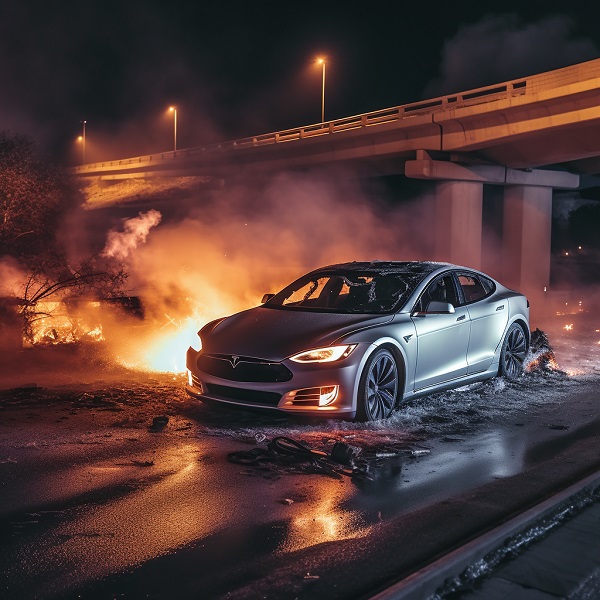Editor’s note: responding to electrical vehicle fires is a new, evolving, difficult, and complex topic. The following article is intended only as the briefest and most superficial of guides. Treat this article as nothing more than an introduction to the topic.
When it comes to handling electric vehicle fires, first responders and firefighters face a unique set of challenges. Electric vehicle (EV) fires are rare but pose a technical and safety challenge for fire departments, as they burn at much higher temperatures and require more water to fight than conventional car fires. There isn’t a consensus on the best firefighting strategies for EVs, and many firefighters in the US are not trained to combat EV fires. Research is still being conducted to improve EV safety by developing flame retardants and exploring new battery chemistries, like solid-state batteries, which are less likely to ignite.
Electric vehicles are powered by high-voltage batteries made up of many cells packed together. These cells are housed in a watertight, fire-resistant box. When one of these cells goes haywire, it can produce a significant amount of gas and heat—around 1,200 degrees Fahrenheit. The assembly consists of multiple battery cells interconnected, and in the event of a fire, the cumulative heat generated by the battery assembly can be significantly higher than that of a single cell failure, with current research suggesting a range of between approximately 2,300 to 5,000 degrees Fahrenheit.
Emergency responders should familiarize themselves with guidelines provided by electric vehicle manufacturers and the NFPA to effectively address EV fires. When approaching an incident, responders should assume the vehicle is a hybrid, electric, or alternatively fueled vehicle until proven otherwise. General procedures include identifying the vehicle type, immobilizing and stabilizing it, and disconnecting the 12-volt battery (Cutting the 12-volt battery in a vehicle that is “on”, however, will not turn the vehicle “off”, as power supplied by the DC/DC convertor may keep the contactor closed). Extrication requires caution around high-voltage components and cables, as well as wearing appropriate PPE.
For fire extinguishment, responders should wear full PPE and use water or other standard agents. It is important to use a large volume of water to extinguish high-voltage battery fires and monitor the battery for reignition using thermal imaging while ensuring a safe storage distance from structures or other vehicles. Emergency responders should also refer to manufacturers’ emergency response guides, which offer vehicle-specific information on disconnecting high-voltage batteries, fighting battery fires, and mitigating risks of stranded energy. These guides may provide guidance on submerged vehicles, post-incident recovery, towing, and storage of damaged electric vehicles.
To approach responding to EV fires effectively, the following general advice and principles can be derived:
- Familiarize yourself with various manufacturers’ guides for disabling high-voltage systems, as they differ in procedures and devices.
- Be aware that disconnecting high-voltage circuits doesn’t de-energize the high-voltage battery itself, so there may still be a risk of electric shock.
- Understand the limitations and accessibility of high-voltage disconnects in EVs, as crash damage and fires may prevent access.
- Recognize the need for more standardized guidance and methods for fighting high-voltage battery fires and addressing stranded energy risks.
- Aim to cool the battery enough to prevent fire propagation to adjacent cells.
- Be aware that extinguishing agents may be difficult to apply directly onto burning cells due to the batteries’ protective cases.
- Acknowledge that the lack of clear, vehicle-specific firefighting information can lead to confusion or inadvisable action on the part of first responders.
Firefighters face challenges in dealing with electric vehicle (EV) fires, particularly those involving high-voltage lithium-ion batteries that undergo thermal runaway. Thermal runaway is an exothermic chemical reaction that occurs when a single cell in a high-voltage battery fails, producing a large amount of heat and gas. This heat can cause neighboring cells to fail in a chain reaction. Once a battery cell undergoes thermal runaway, it is impossible to extinguish the failed cell, as the chemical reaction occurs too quickly.
While there is no simple solution to stop thermal runaway, directly cooling the battery cells is the best method. However, it is not easy to gain access to the inside of the battery box, where the cells are housed. Firefighting foam, Class D extinguishers, pancake nozzles, fire blankets, and piercing nozzles all have their limitations and may not be effective in stopping a thermal runaway event due to the design of the battery box, the speed at which battery cells fail, and the fact that lithium-ion batteries do not require external oxygen to burn.
Sometimes the best solution is to let the battery burn itself out, especially if the battery box is intact and there are no exposure risks. This strategy may not be ideal, but it is the most effective approach. It should only take about an hour for the battery to burn itself out, while the alternative would be to continuously apply water to the vehicle for 6 to 8 hours. Firefighters should take caution to wear proper personal protective equipment (PPE) and be aware of the potential release of harmful and flammable gases, such as hydrogen and hydrogen fluoride, which can occur during a battery fire.
Vehicle manufacturers have taken steps to standardize emergency response guides (ERGs) for electric vehicles, with standardized labels, colors, symbols, and graphics to help identify a vehicle’s fuel or energy used for propulsion. These ERGs comply with the International Organization for Standardization’s (ISO’s) Standard 17840, and most manufacturers have posted these guides on their websites, free to download.
The International Association of Fire Chiefs (IAFC) provides guidance to fire departments on how to respond to electric vehicle (EV) fires. According to the IAFC’s Fire Department Response to Electric Vehicle Fires Bulletin, fire departments should modify or establish department policies or standard response guidelines to include electric vehicle fires. These guidelines should include circumstances under which crews should allow the vehicle to burn.
The IAFC recommends assessing the extent of the fire and determining whether it involves the electric components of the vehicle when arriving on the scene of an EV fire. In managing or controlling a battery fire, water is the best method. Firefighters should consider their tactical approach, which may be categorized as offensive or defensive mode, based on exposures and the extent of the fire. The use of a thermal imaging camera is advised for the size-up.
When attacking the vehicle fire, it is important to understand that once the contents of the fire are extinguished, sustained suppression on the battery pack may be necessary. Firefighters should use a large volume of water to suppress and cool the fire and the battery. A continuous and sustainable water supply from fire hydrants or water tenders is needed. Firefighters should be prepared for an extended operation to monitor the battery’s heat or possible secondary ignition, as the heat from the fire may have damaged additional cells and may require further suppression.
In the post-incident phase, the IAFC advises briefing towing companies and their personnel on the hazards, including providing a 50-foot clear space around the vehicle once stored and ensuring it is never stored inside a building. An engine company may need to escort the vehicle to the recovery location. Batteries should always be treated as energized and may pose an ongoing risk to the investigator. Thermal events with the battery system could continue for some time after the initial incident, so fire departments should establish response protocols for secondary fires.
Handling electric vehicle fires is challenging, and it takes a cool head and a steady hand to navigate these tricky situations. But with the right knowledge and a little patience, first responders can rise to the challenge and keep our roads safe. So the next time you’re cruising down the highway in your electric vehicle and you see a plume of smoke on the horizon, remember that there’s a team of brave men and women ready to jump into action. And whether they’re wrestling with thermal runaway or dousing flames with water, you can be confident that they’ll get the job done.
References and Resources:
- Emergency Response Guides for Electric Vehicles and Lithium-ion Batteries (FEMA)
- ISO 17840-1:2022 – Road vehicles — Information for first and second responders — Part 1: Rescue sheet for passenger cars and light commercial vehicles
- Safety Risks to Emergency Responders from Lithium-Ion Battery Fires in Electric Vehicles, National Transportation Safety Board (NTSB), Safety Report, NTSB/SR-20/01, PB2020-101011
- Rosenbauer Battery Extinguishing System Technology (BEST) – Battery Fires, Promotional Video
- https://www.meyerfire.com/daily/how-best-to-actually-fight-electric-vehicle-fires
- FireRescue1: Tesla On Fire, How to Extinguish an Electric Car Fire, FireRescue1 and its network of fire sites are part of Lexipol, the nation’s leading content, policy and training platform for public safety and local government, enabling first responders and leaders to better protect their communities and reduce risk.
- FireRescue1: Electric Vehicle Fires, Where the Waiting Game Wins
- Best Practices for Emergency Response to Incidents Involving Electric Vehicles Battery Hazards: A Report on Full-Scale Testing Results, The Fire Protection Research Foundation
- https://www.dekra-roadsafety.com/en/what-to-do-if-an-electric-car-catches-fire/
- Sun, Peiyi & Bisschop, Roeland & Niu, Huichang & Huang, Xinyan. (2020). A Review of Battery Fires in Electric Vehicles. Fire Technology. 1-50. 10.1007/s10694-019-00944-3.
- Takahashi, M., Takeuchi, M., Maeda, K., and Nakagawa, S., “Comparison of Fires in Lithium-Ion Battery Vehicles and Gasoline Vehicles,” SAE Int. J. Passeng. Cars – Electron. Electr. Syst. 7(1):213-220, 2014, https://doi.org/10.4271/2014-01-0428.
- IAFC’s Fire Department Response to Electric Vehicle Fires Bulletin










